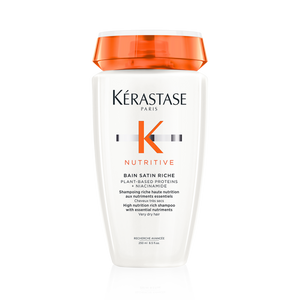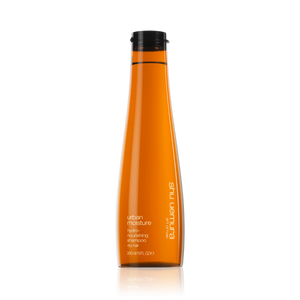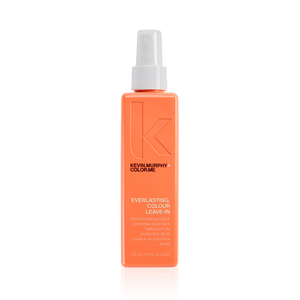Could hair extensions help you achieve your dream look?
Hair extensions have come a long way in recent years. The development of high-quality, barely detectable bonds, weaves and tapes means that extensions are now used for much more than just adding length to your locks.
"We call it 'hair Botox,'" says creative director Alfie Oneill of the technique where sections are added to create volume.
"For clients who are experiencing their hair getting finer or they have general thinning, they will have a few extensions just to fill it out a little bit."
For clients who want to rock a glamorous, Nineties-inspired bob, extensions can make all the difference.
"If they want a big blow out and the clients find their own hair doesn't hold great then adding extra hair extensions whether bonds or tapes, enables them to add a slightly different texture that blends well with your own hair. It also means that styling can be easier and allow for versatility especially when creating hold for that longer lasting blow out," says artistic director Zoe Rodgers.
Extensions can also be used to create a trendy fringe, while for some clients it's all about a celeb-worthy statement look.
"Like when Kim Kardashian has her hair really long, very sleek and very dark," Zoe says. "That long, shiny, healthy hair is very hard to get naturally."
Whatever your wish, it's important to understand the different types of extensions and what can be achieved with your hair as the starting point.
Here, our experts talk through everything you need to know if you want to try the latest hair trends with a little help from some extensions…
Types of hair extensions

There are various types of hair extensions, Bonded, Wefts, Tapes and Pieces, available at Paul Edmonds London, but we are going to focus on Bonded hair extensions and Wefts.
Bonded hair extensions
Bonded hair extensions are small sections held together at the top with keratin (one of the building blocks of hair), which melts when heated so the section can be 'glued' onto strands close to the scalp.
"This is the most bespoke method," Zoe says. "We use those either to fill out hair or to add some colour."
You can choose to have just a few sections or lots for a more dramatic transformation, Alfie says: "I might do five of them on each side for some people and then do hundreds in others."
At Paul Edmonds, we use some great suppliers of hair from Great Lengths to Remi Cachet for bonds and pro tips, and there's a huge range to choose from, Zoe says: "They have balayage ones, they have some which are darker at the root and lighter at the end so it looks really natural - you wouldn't know they were extensions"
Bonds are the most long-lasting option, but need to be removed in salon, she adds: "The maximum wear you'd get is about three to four months, depending on how fine the hair is and how fast it grows, because once the hair grows the bonds will become visible."
A point to consider with bonds are that once the hair has been used and taken out they can not be reused again, however at Paul Edmonds London, there is also the Pro tip hair extensions, which are flat micro tips that are clipped into the hair (you can still decide on the colour length and volume) and reapplied every 6 weeks, the added advantage is that they can be reused (depending on how well you look after them) the disadvantage is that they are not invisible to the eye at the root, but they are a great alternative for those clients who want to invest in extensions that can be reapplied and reused for a longer period.
Weft or weave hair extensions
Weft hair extensions - also known as weaves - are sewn into the hair, meaning they can be reused.
"It's one big strip of hair which you cut to the shape of the person's head," says creative director Jenni Manzi.
"You use micro rings and sewing to attach it to the head. They're easy to get in and out, and you can have them tightened every six weeks, so you get a bit more wear compared to bonds."
At Paul Edmonds London this type of weft application is called the LA Weave, a reference to the gorgeous full look of thick long lustrous hair that celebrities would appear to obtain literally overnight.
Which type of extension is best for you?

A thorough consultation with an extentionist is a crucial first step if you're thinking about getting hair extensions, to talk through the look you want to go for, whether it's suitable for your hair type and lifestyle, and the best type of extensions to use.
"It depends on the client, what they want, what their hair is like and if it's strong enough for the bonds," says Jennie.
While extensions can be a great way to bulk out fine or thinning hair, there needs to be enough existing strands to attach the sections to.
"If someone has alopecia or a lot of breakage from colouring their hair it might not be possible," Zoe says.
It's also important to remember that extensions take a certain level of upkeep.
"If they're a client who is a 'wash and wear' type then it's not going to be for them because there is maintenance with it," Zoe says (more on that topic below). "You've got to look after extensions like you would your own hair."
Make sure you go to a reputable salon, Alfie warns: "Some extensions aren't ethically sourced, you have to be quite careful with where the hair comes from."
Depending on the application type and number of sections, an appointment to have hair extensions put in can take anything from 30 minutes to two hours or more.
At Paul Edmonds, we can advise on the best person for your look, Zoe says: "I would always pass my client over to the correct extensionist if I couldn't do the service they want."
And we'll make sure the right stylist completes your look, she adds: "The shaping afterwards is important because hair extensions are totally different to your own hair. They have to be cut professionally and cut very, very well otherwise it will look like the extensions that have just been plopped in."
Trends to try with hair extensions

Update your look with a colour fresh, curtain fringe or bouncy bob created with hair extensions.
Fringes
Has your Instagram feed been full of people unveiling their sweeping, centre-parted fringes recently?
"Curtain bangs - that's what everyone's asking for at the moment," Zoe says. "If someone wants a heavier fringe, flat bonds are great. They go underneath the hair"
Jennie agrees: "They're ideal for someone who wants that heavy open fringe but doesn't have enough hair at the front."
Balayage
A free-hand colouring technique, balayage is used to create beautiful, natural-looking highlights and lowlights.
"If you don't want to add bleach to your hair you can do balayage with extensions," Jennie explains.
The Great Lengths 'piano' range is so called because the sections contain two colours within one strand, like piano keys.
"They range from light blonde - so you could have an ash blonde with the golden blonde - or you could have a dark brown mixed with a chocolate brown," Zoe says.
"Nowadays people don't have all one colour in their hair, they want it multi-tonal."
Bouncy 90s hair
Inspired by Nineties supermodels, voluminous bobs and mid-length styles are in demand right now.
"Extensions are great if you've got short hair to help you grow it," Zoe says.
"I had a lady in the salon recently, she had quite short hair and wanted a longer bob so I added sections from the mid back and sides to the front. She got the look that she wanted and was really happy."
How should you maintain your hair extensions?

To keep hair extensions in optimal condition you need to wait 48 hours after they've been applied to wash your hair.
"With extensions you need to use more luxury brands - organic shampoos and conditioners tend to be a bit drying," says Zoe, who recommends Kérastase or Shu Uemura products.
"After washing you have to make sure you brush the roots with a soft brush so the hair doesn't get tangled around the bond."
Alfie suggests using a Mason Pearson or detangling brush: "Spray leave-in conditioner to keep the hair really soft. Make sure you're brushing from the scalp down, combing down the hair shaft to release the hair that's around the bond or weft."
He warns against using purple shampoo, even on blonde hair: "All extensions have been chemically stripped and then recoloured so it grabs the pigment."
Jennie says: "Serums and oils are also recommended because it keeps them shiny, but just not near the roots."
Similarly, you've got to be careful when using heated styling tools.
"With wefts you can put straighteners or a curling wand fairly close to the root, but with bonds you can't otherwise they'll melt," Zoe says.
Blow drying bonded hair extensions is recommended to make sure the hair close to the roots is thoroughly dry, then make sure long hair is protected when you go to bed, Zoe adds: "Tie it up or put it in a braid or soft ponytail to prevent tangles.

The long and short of it
Hair extensions can be used to create a huge variety of styles, from directional bobs and face-framing fringes to flowing waves and poker-straight locks.
Whether bonded or weft, extensions are quite a commitment, so you need to make sure you get the right type for your hair and be prepared for the maintenance they require.
Wondering if extensions would work for you? Book a consultation at Paul Edmonds London to talk through your options with one of our extension specialists.



